|
MONDAY
15th APRIL 2003 (Day 1)
After
a disturbed night I was up at 04.30 to finish packing and to get
everything together ready for my departure. Carol rose at 05.00 and
after a quick breakfast she drove me to Smith's Coaches garage. There
the coach was waiting with Alan and Kath already aboard. They had taken
the front left seats so I sat immediately behind them. At 05.30 Brian,
our driver for the trip, headed into Marple. Soon we were standing by
the Regent Cinema and most of the rest of the party were boarding. Alan
and Kath were asked to move to the seats behind me so that Pete and Andy
could occupy the front ones with all their trip-running gear. I can
understand their desire to be at the front of the coach. Having
organised many similar trips I appreciate that the position near to the
driver at the front of the coach is the best from which to try to
control everything.
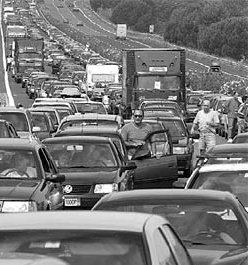 By
06.00 we were on our way and after picking up Jack at the Texaco garage
and a few more people in Offerton we made for the motorway. We had
another pickup at the Knutsford services before our final one at the
Stafford services, where we met Ray and his wife. Ray and I had shared a room
last year but this year his wife had come between us. Then it was full
tilt down the M6 into the first traffic jam. This was caused by what
proved to be an horrific accident involving a heavy goods vehicle. Its
cab was completely destroyed and several fire crews were hacking at the
debris, presumably to try to extricate the driver. I hope they were
successful. By
06.00 we were on our way and after picking up Jack at the Texaco garage
and a few more people in Offerton we made for the motorway. We had
another pickup at the Knutsford services before our final one at the
Stafford services, where we met Ray and his wife. Ray and I had shared a room
last year but this year his wife had come between us. Then it was full
tilt down the M6 into the first traffic jam. This was caused by what
proved to be an horrific accident involving a heavy goods vehicle. Its
cab was completely destroyed and several fire crews were hacking at the
debris, presumably to try to extricate the driver. I hope they were
successful.
Then
came Birmingham!!
It
was not until 09.30 that we reached Watford Gap services where we had
breakfast. We stopped for only thirty minutes during which I had a
horrid few rashers of soggy tasteless bacon between two slices of flabby
white sliced bread. With a pot of lukewarm coffee the bill was £5.38.
I've had a roast Sunday lunch in a pub for that sort of money - and
enjoyed eating it.
The
journey continued on around London. On the crest of the Queen Elizabeth
II bridge I was impressed by the fantastic scope of the view. What a
pity that the only things to see are part of a very unattractive
industrial landscape and the dirty river.
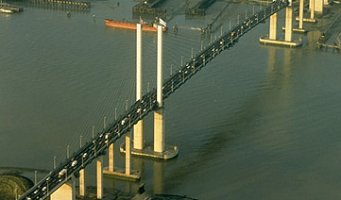
One
more stop and at 13.15 we were in the Eurotunnel terminal and driving on
to the train. This was my first journey under the English Channel and,
quite frankly, I wasn't looking forward to it. The train comprised
thirty units and we had the seventh one all to ourselves. Soon the
shutters between the units came down and we were sealed into the
compartment. For most of the trip we stood outside the coach as it was
too warm inside. The view from the compartment windows was,
understandably, not exciting. Thankfully the crossing took only a short
time and by 15.05 (local time) we were in France and heading northwards
towards Belgium
ARNEKE
CEMETERY
|
In
October 1917 the 13th Casualty Clearing Station moved back from
near Proven to Arneke and around it grew up the British
Cemetery. The 10th and 44th Clearing Stations joined it in April
1918. The cemetery was used by these hospitals until the end of
May and again from July to September 1918 by the 62nd (1/2
London) Clearing Station. In November the 4th and 10th
Stationary Hospitals used it for a short time. There are now
nearly 450 1914-18 and a small number of 1939-45 war casualties
commemorated in this site. |
The
first stop, at 16.30, was at Arneke military cemetery. It was a typical
Commonwealth War Graves Commission cemetery, situated down a narrow lane
and almost in the adjacent farmyard where Brian managed to turn the
coach around. As is usually the case the graves were enclosed by a small
wall. At the heart of the area is a white stone cross superimposed upon
which is a large bronze sword. Behind is the Stone of Remembrance
bearing the words 'THEIR NAMES LIVETH FOR EVERMORE'.
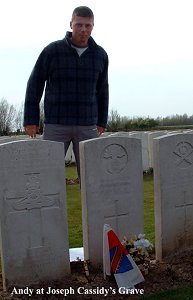 The
chief reason for visiting this particular site was for Frank to pay his
respects at the grave of an uncle, Private Joseph Cassidy of the Royal
Irish Fusiliers. He died at the age of 21 on 10th September 1918 of
wounds he had suffered at Messines. Arneke cemetery marks the site of a
casualty clearing station. This means that most of the graves are of soldiers who died there after they had been transported
from the front line. As a result, most if not all the headstones are able
to give the full details of the soldiers under them; their rank, name
and number, their regiment and the date on which they died. Often their
age is included and, at the bottom of the stone, a few lines are added by their
family. It also means that many different regiments and corps are
represented. There were also several French graves as a well as a few
German ones. Arneke cemetery is also the last resting-place of a Marple
man, F. S. Carter of the Cheshire Regiment. The
chief reason for visiting this particular site was for Frank to pay his
respects at the grave of an uncle, Private Joseph Cassidy of the Royal
Irish Fusiliers. He died at the age of 21 on 10th September 1918 of
wounds he had suffered at Messines. Arneke cemetery marks the site of a
casualty clearing station. This means that most of the graves are of soldiers who died there after they had been transported
from the front line. As a result, most if not all the headstones are able
to give the full details of the soldiers under them; their rank, name
and number, their regiment and the date on which they died. Often their
age is included and, at the bottom of the stone, a few lines are added by their
family. It also means that many different regiments and corps are
represented. There were also several French graves as a well as a few
German ones. Arneke cemetery is also the last resting-place of a Marple
man, F. S. Carter of the Cheshire Regiment.
On
the way to our next stop we passed close by the Mont des Cats. Andy
informed us that this is the very hill up which the Grand Old Duke of
York marched his 10,000 men before immediately marching them down again.
Generally this part of France/Belgium is very flat with only a few
small hills that dominate the surrounding countryside. It is easy to see
why the occupation of even such low hills became so vital to the
combatants of the Great War and, as we were to see, cost the lives of so
many men.
BAILLEUL
CEMETERY
|
Bailleul
was occupied on the 14th October 1914 by the 19th Brigade and
the 4th Division. It became an important railhead, air depot and
hospital centre; the 2nd, 3rd, 8th, 11th, 53rd, 1st Canadian and
1st Australian Casualty Clearing Stations were quartered in it
for considerable periods. It was a Corps Headquarters until July
1917 when it was severely bombed and shelled. The battle of
Bailleul, one of the Battles of the Lys, was fought between the
13th and 15th April 1918. The town was defended by the 29th,
31st, 34th and 59th (North Midland) Divisions and the 4th Guards
and 147th Brigades but it was entered by the Germans on the
evening of the 15th. By the end of the month the enemy advance
was held at St. Jans-Cappel and Meteren, north and west of
Bailleul, and the allied artillery had destroyed the town. It was
found empty and reoccupied on 30th August 1918.
There
are now nearly 4,500 1914-18 and a small number of 1939-45 war
casualties in this site. Of these nearly 200 from the 1914-18
War are unidentified and eleven special memorials record the
names of soldiers from the United Kingdom buried here in April
1918 whose graves were destroyed by shell fire. |
The
next cemetery, Bailleul, was between a housing estate and the local
civil graveyard. Again it marked the site of a casualty
clearing station and, being closer to the front, was larger than that at
Arneke. Once wounded, a soldier received initial basic treatment at the
regimental aid post before being passed back to the nearest dressing
station. Here an attempt would be made to stabilise the patient and make
him fit enough to be moved back to a casualty clearing station and
eventually, if he survived the journey, to a base hospital near the
Channel coast such as the one at Étaples that we visited last year.
Needless to say, many men did not complete this journey, made by any of
a variety of means of transport - motorised or horse-drawn ambulance,
train or canal barge. Their last resting places mark the smaller
clearing stations along the line of evacuation where they finally gave
up their sad struggle for life.
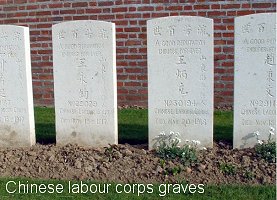 Bailleul
was also the scene of much hard fighting during the last German push and
its subsequent repulse in 1918. Some of the battle dead are buried in
this cemetery. For the first time on this trip we saw nameless graves,
their occupants 'KNOWN UNTO GOD'. The cemetery also contains some
unusual headstones. In among the usual British Army regiments we came
across the stones for men of the Indian Army who died so far from their
homeland in a cause they must have found difficult to understand. There
were Ghurkas and Pathans with their details recorded in strange scripts.
At the back of the cemetery was a row of stones marking the graves of
thirty members of the Chinese Labour Corps buried between November 1917
and March 1918. Bailleul
was also the scene of much hard fighting during the last German push and
its subsequent repulse in 1918. Some of the battle dead are buried in
this cemetery. For the first time on this trip we saw nameless graves,
their occupants 'KNOWN UNTO GOD'. The cemetery also contains some
unusual headstones. In among the usual British Army regiments we came
across the stones for men of the Indian Army who died so far from their
homeland in a cause they must have found difficult to understand. There
were Ghurkas and Pathans with their details recorded in strange scripts.
At the back of the cemetery was a row of stones marking the graves of
thirty members of the Chinese Labour Corps buried between November 1917
and March 1918.
We
had stopped here to visit the grave of Private John Cassidy, another of
Frank's uncles and older brother of Joseph Cassidy whom we had visited in
Arneke cemetery. John had also been in the Royal Irish Fusiliers but had
died of wounds on 17th November 1916. We wondered if, as he was
evacuated along the railway line, his younger brother had realised how
close he was passing to his already dead brother's grave.
Along
the edge of the cemetery were a number of German graves. A few of these
held men killed in 1944 when war once again passed through this part of
France.
At
18.15 we finally entered Belgium. A dilapidated border post, badly
decorated with graffiti, was the only indication of the transition from
one country to another. Soon we could see the spires of Ypres (or Ierper
as the local Flemish people prefer to know it) and the famous Cloth
Hall, all carefully reconstructed since 1918. It is hard to remember
that over 250,000 British troops died around here, representing one in
four of all the British dead for the whole of the war. Having rounded
Hellfire corner, allegedly the most shelled part of the whole front
line, we entered Ypres through the Menin Gate and eventually stopped
outside our hotel, the Ypres Novatel.
We
soon disembarked and Robin, my roommate for the week, and I headed for
our room. It came as some surprise to discover that the large and bright
room contained only one large double bed. We eventually became friends
but to start the friendship by sharing a bed was a big concept to grasp.
A quick visit back to Reception was enough to discover that the sofa
under the window was also a single bed so that solved that potential
problem.
THE
MENIN GATE AND "THE LAST POST" CEREMONY
|
The
original Menin Gate marked the start of one of the main roads
out of Ypres towards the front line. Tens of thousands of men
passed through it and along the infamous Menin Road. Too many of
them never returned. Then there was no actual gate and certainly
no arch. It was merely a gap in the town's ramparts with a
bridge across the moat.
Following
the end of the Great War, plans were discussed for a suitable
memorial in Ypres. The British Government suggested purchasing
the ruins of the town and leaving it as a memorial to the
soldiers and townspeople who had lost their lives in the
Salient. The Belgian Government refused to sanction this plan
but offered two possible sites in the town, the ruined Cloth
Hall or the Menin Gate. Following a change of heart over the
Cloth Hall it was decided to erect a memorial on the site of the
Menin Gate to those members of the British and Empire armies who
had died in the fighting around Ypres and who had no known
grave.
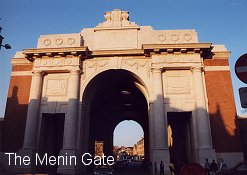 The
Gate was designed by Sir Reginald Blomfield and finally
completed, despite considerable construction difficulties, in
1927. It represents a great triumphal arch in the classical
Roman tradition. Made of French limestone and weighing 20,000
tons, the monument is 135 feet in length, 140 feet wide and 80
feet high. At the summit is a British Lion designed by Sir
William Reid Dick. It was intended to look "not fierce and
truculent, but patient and enduring, looking outward" along
the Menin Road. On great panels, all around the walls, are the
names of 54,896 officers and men of the Commonwealth forces.
This figure does not represent all the men who disappeared in
the Salient. It was discovered that the Menin Gate, huge as it
is, was not large enough to hold all the names of the missing.
The names recorded on its panels are of the men who died between
the outbreak of war in 1914 and 15th August 1917. The names of a
further 34,984 who went missing from then until the end of the
war are recorded on carved panels at Tyne Cot cemetery. The
Gate was designed by Sir Reginald Blomfield and finally
completed, despite considerable construction difficulties, in
1927. It represents a great triumphal arch in the classical
Roman tradition. Made of French limestone and weighing 20,000
tons, the monument is 135 feet in length, 140 feet wide and 80
feet high. At the summit is a British Lion designed by Sir
William Reid Dick. It was intended to look "not fierce and
truculent, but patient and enduring, looking outward" along
the Menin Road. On great panels, all around the walls, are the
names of 54,896 officers and men of the Commonwealth forces.
This figure does not represent all the men who disappeared in
the Salient. It was discovered that the Menin Gate, huge as it
is, was not large enough to hold all the names of the missing.
The names recorded on its panels are of the men who died between
the outbreak of war in 1914 and 15th August 1917. The names of a
further 34,984 who went missing from then until the end of the
war are recorded on carved panels at Tyne Cot cemetery.
Unveiling
the memorial on 24th July 1927 Field Marshal Plumer said: -
One
of the most tragic features of the Great War was the number of
casualties reported as missing, believed killed… When peace
came and the last ray of hope had been extinguished the void
seemed deeper and the outlook more forlorn for those who had no
grave to visit, no place where they could lay tokens of loving
remembrance…and it was resolved that here at Ypres, where so
many of the missing are known to have fallen, there should be
erected a memorial worthy of them which should give expression
to the nation's gratitude for their sacrifice and their sympathy
with those who mourned them. A memorial has been erected which,
in its simple grandeur, fulfils this object and now it can be
said of each one in whose honour we are assembled here today: He
is not missing; he is here! |
|
By
19.30 we were back down in the bar for a quick beer as the group
assembled. A quarter of an hour later we walked back to the Menin gate
to witness the regular evening ceremony of sounding the Last Post.
Tonight a crowd of about 200 people had congregated under the arch.
Sharp at 20.00, five smartly dressed firemen formed up across the road
and sounded the British Army's Last Post, the bugle call that
traditionally ends the day and is also sounded at military interments.
During the ensuing reverential silence various groups laid poppy wreaths
at the memorial. Tom and Joan, his grandmother, placed the one from the
Marple group. Finally the bugles sounded Reveille, the call that signals
the start of a new day.
THE
LAST POST
|
 |
|
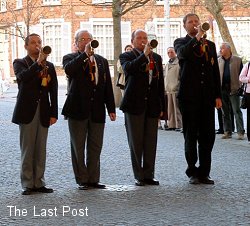 In
1928, a year after the inauguration of the Menin Gate Memorial,
a number of prominent citizens in Ypres decided that some way
should be found to express the gratitude of the Belgian nation
towards those who had died for its freedom and independence. The
idea of the daily sounding of the Last Post - the traditional
salute to the fallen warrior - was that of the Superintendent of
the Ypres police, Mr. P. Vandenbraambussche. The Menin Gate was
thought to be the most appropriate location for the ceremony.
The privilege of playing the Last Post was given to buglers of
the local volunteer Fire Brigade. In
1928, a year after the inauguration of the Menin Gate Memorial,
a number of prominent citizens in Ypres decided that some way
should be found to express the gratitude of the Belgian nation
towards those who had died for its freedom and independence. The
idea of the daily sounding of the Last Post - the traditional
salute to the fallen warrior - was that of the Superintendent of
the Ypres police, Mr. P. Vandenbraambussche. The Menin Gate was
thought to be the most appropriate location for the ceremony.
The privilege of playing the Last Post was given to buglers of
the local volunteer Fire Brigade.
The
first sounding of the Last Post took place on 1st July 1928 and
a daily ceremony was carried out for about four months. The
ceremony was reinstated in the Spring of 1929 and the Last Post
Committee was established. From 11th November 1929 the Last Post
has been sounded at the Menin Gate every night and in all
weathers. The only exception to this was during the four years
of the German occupation of Ypres from 20th May 1940 to 6th
September 1944. The daily ceremony was instead continued in
England at Brookwood Military Cemetery in Surrey. On the very
evening that Polish forces liberated Ypres the ceremony was
resumed at the Menin Gate in spite of the heavy fighting still
going on in other parts of the town. |
I
spent a few moments examining the names on the many marble panels that
cover every surface of the great construction. Every regiment and corps
in the British and Commonwealth armies is represented; men from the
English counties and towns, the Scottish Highlands and the Welsh
valleys, from Ireland, Canada, Australia, New Zealand, South Africa and
India. It is almost too staggering to take in at one visit.
The
following Marple men are remembered on the walls of the Menin Gate (with
the date of their death): -
| Robert Ashton |
06/03/1915 |
| Francis Edmund
Bradshawe Isherwood |
09/05/1915 |
| Geoffrey
Hamilton Bagshawe |
13/05/1915 |
| Joseph Ardern |
20/06/1915 |
| Burt Morris |
07/06/1917 |
| John William
Hallworth |
13/06/1917 |
| Joseph Bell |
27/07/1917 |
| John William
Hayes |
31/07/1917* |
| Fred Hopwood |
31/07/1917* |
| Bertram Smith |
31/07/1917* |
| John Thomas
Booth |
31/07/1917* |
| Harold Matthew
Burton |
31/07/1917* |
| Robert Cunningham
Dixon |
31/07/1917* |
| James Everatt
Sharples |
03/08/1917 |
*
31st July 1917 was the start of the disastrous part of the Third Battle
of Ypres generally referred to as The Battle of Passchendaele.
After
the ceremony most of us repaired to a bar in the town square for a drink
and something to eat. I had steak with a mushroom sauce, which was very
tasty, with plenty of mushrooms. Those new to Belgium were fascinated by
the drinks menu with its long list of Belgian beers. Not everyone
realised that some of these beers are considerably stronger that our own
ales!
It
had been a long day and by the end of the meal I was feeling very tired.
Some of the party went off to another bar to continue the evening but I
crept back to the hotel and my bed.
THE
FIRST BATTLE OF YPRES - OCTOBER TO NOVEMBER 1914
|
With
the failure of the German offensive against France at the battle
of the Marne and the allied counter-offensive, the so-called
Race to the Sea began, a movement towards the North Sea coast as
each army attempted to out-flank the other by moving
progressively north and west. As they went, each army
constructed a series of trench lines that came to characterise
the war on the Western front until 1918.
Meanwhile
on 14th September the French Commander-in-Chief, Joseph Joffre,
undertook an intensive combined allied attack against the German
forces on the high ground just north of the Aisne River. The
German defences were too strong and the attack was called off on
18th September. Stalemate had set in.
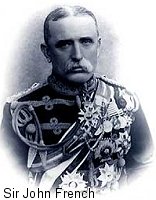 By
October the Allies had reached the North Sea at Niuwpoort in
Belgium. German forces had driven the Belgian army out of
Antwerp and back towards Ypres. The British Expeditionary Force
(BEF) under Sir John French took over the line from Ypres south
to La Bassée in France from which point the French Army
continued the line down to the Swiss Border. Such was the
background to the First Battle of Ypres that commenced on 14th
October 1914 when Eric von Falkenhayn, the German Chief of
Staff, sent his 4th and 6th Armies into Ypres. By
October the Allies had reached the North Sea at Niuwpoort in
Belgium. German forces had driven the Belgian army out of
Antwerp and back towards Ypres. The British Expeditionary Force
(BEF) under Sir John French took over the line from Ypres south
to La Bassée in France from which point the French Army
continued the line down to the Swiss Border. Such was the
background to the First Battle of Ypres that commenced on 14th
October 1914 when Eric von Falkenhayn, the German Chief of
Staff, sent his 4th and 6th Armies into Ypres.
The
battle began with a nine-day German offensive that was only
halted with the arrival of French reinforcements and the
deliberate flooding of the Belgian front. Belgian troops opened
the sluice gates of the dykes holding back the sea from the low
country. The flood encompassed the final ten miles of the
trenches in the far north and would later prove a hindrance to
the movement of allied troops. During the German attack British
troops held their positions, suffering heavy casualties, as did
the French forces guarding the north of the town.
The
second phase of the battle saw a counter-offensive launched by
General Foch on 20th October, ultimately without success. It was
ended on 28th October.
Next
von Falkenhayn renewed his offensive on 29th October, attacking
most heavily in the south and east, once again without decisive
success, although by 1st November they had taken Messines Ridge,
Wytschaete and Gheluvelt and had broken the Menin Road. It
seemed as though an allied defeat was imminent. However, the
arrival of French reinforcements saved the town, the British
were able to counter-attack and Gheluvelt was recaptured.
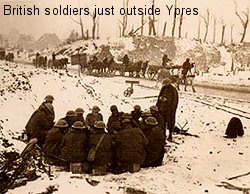 The
German offensive continued for the following ten days, the fate
of Ypres still in the balance. A further injection of French
reinforcements arrived on 4th November. Even so, evacuation of
the town seemed likely on 9th November as the German forces
pressed home their attack, taking St. Eloi on 10th November and
pouring everything into an attempt to recapture Gheluvelt on
11th and 12th November, but without success. A final major German
assault was launched on 15th November. Still Ypres held out. Now
the Belgian autumn had set in and soon heavy rain arrived
followed by snow. Von Falkenhayn called off his attack. The
German offensive continued for the following ten days, the fate
of Ypres still in the balance. A further injection of French
reinforcements arrived on 4th November. Even so, evacuation of
the town seemed likely on 9th November as the German forces
pressed home their attack, taking St. Eloi on 10th November and
pouring everything into an attempt to recapture Gheluvelt on
11th and 12th November, but without success. A final major German
assault was launched on 15th November. Still Ypres held out. Now
the Belgian autumn had set in and soon heavy rain arrived
followed by snow. Von Falkenhayn called off his attack.
It
was becoming evident that the nature of trench warfare favoured
the defender rather than the attacker. The BEF had held Ypres as
they continued to do until the end of the war despite repeated
German assaults. The Allies now held a salient extending six
miles into the German lines. The cost had been huge on both
sides. British casualties were 58,155, mostly from the pre-war
professional army - the last of the Old Contemptibles. French
casualties were around 50,000 and Germany lost 130,000 soldiers. |
|